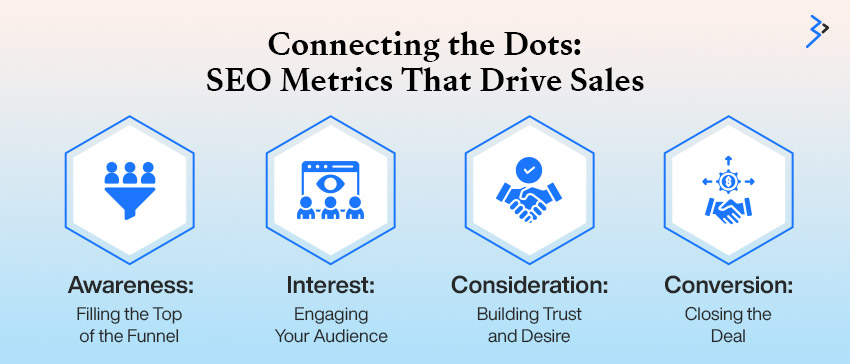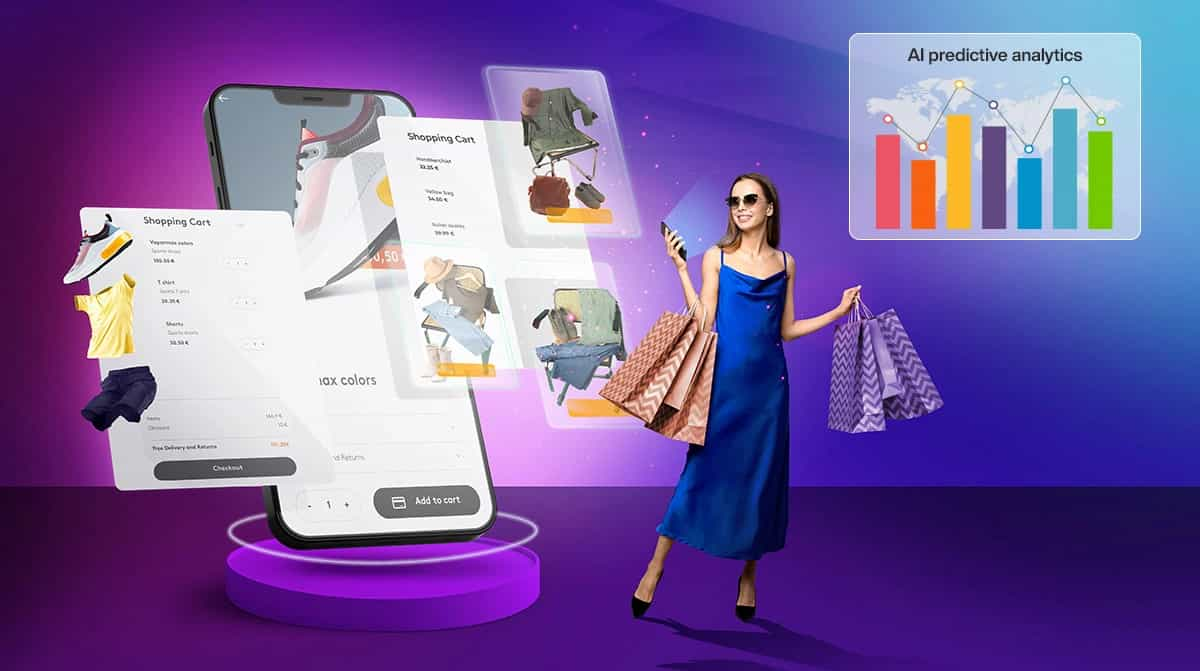Table of contents
The Conversion Funnel: Your Roadmap to Revenue
Connecting the Dots: SEO Metrics That Drive Sales
Optimizing Your Conversion Funnel with SEO Data
Real-World Application: The "Lost" High-Intent Keywords
Conclusion: Your Analytics-Driven Blueprint for Sales Success
Frequently Asked Questions (FAQs)
We often get this question: “SEO is great for traffic, but how does it actually translate into sales?” It’s a query that cuts right to the heart of what truly matters in businesses.
In a world flooded with seas of data, simply driving visitors to your site isn’t enough. The real magic happens when you transform that traffic into tangible revenue.
This is where the power of SEO analytics truly shines. It’s the bridge that connects your hard-earned search engine visibility to your bottom line. Forget just tracking rankings; we’re talking about a sophisticated approach to understanding your customer’s journey, identifying bottlenecks, and optimizing every stage of your conversion funnel to drive commercial success. It’s about moving beyond vanity metrics and into the realm of actionable insights that directly boost your sales.
So, let’s dive right in!
The Conversion Funnel: Your Roadmap to Revenue
To effectively connect SEO efforts to sales, we first need to understand the customer’s journey through the conversion funnel. This isn’t a new concept, but applying an SEO lens to each stage helps you optimize more accurately. While variations exist, a common funnel looks something like this:
The SEO Conversion Funnel Stages and Key Metrics
| Funnel Stage | Customer Goal | SEO Goal | Key SEO Metrics |
| Awareness | Discover solution/brand | Increase visibility for broad queries | Organic Impressions, Organic Clicks, Keyword Rankings (top of funnel), Search Visibility |
| Interest | Learn more, explore options | Engage users with valuable content | Organic Traffic, Time on Page, Pages per Session, Bounce Rate, Scroll Depth |
| Consideration | Evaluate products/services | Provide detailed information, build trust | Organic Traffic to product/service pages, Reviews Read, Product Comparisons, Trial Sign-ups |
| Conversion | Make a purchase/take action | Streamline path to purchase, remove friction | Organic Conversion Rate, Revenue from Organic, Average Order Value (AOV), Cart Abandonment Rate |
| Loyalty/Advocacy | Repeat purchase, recommend | Build brand affinity, encourage reviews | Repeat Organic Purchases, Customer Lifetime Value (CLV), Organic Review Generation |
INFOGRAPHIC IDEA: A funnel with 3 divisions, pointers on the side (side annotations), and title
INFOGRAPHIC CONTENT:
TITLE: The SEO Revenue Funnel
- (Top) Awareness: Organic Impressions, Top-ranking keywords.
(Side Annotations) Optimize Meta Tags Here
- (Middle) Interest/Consideration: Organic Traffic, Time on Page, Bounce Rate, Key Landing Pages.
(Side Annotations) Improve UX Here
- (Bottom) Conversion/Loyalty: Organic Conversion Rate, Revenue from Organic, AOV, CLV.
(Side Annotations) Streamline Checkout Here
Connecting the Dots: SEO Metrics That Drive Sales

Let’s dive into how specific SEO analytics can be leveraged at each stage to impact your sales figures significantly.
01 | Awareness: Filling the Top of the Funnel
At this initial stage, potential customers are just beginning to recognize a need or problem. They’re using broad, informational search queries. Your goal is to be visible.
Organic Impressions & Clicks (Google Search Console)
According to Link-Assistant.com, approximately 94% of user clicks are directed to organic listings rather than paid ads. This underscores the immense value of organic visibility.
Organic impressions and clicks indicate how frequently your content appears in search results and how many times users click on it. A high impression count for relevant keywords indicates good visibility. At the same time, a low click-through rate (CTR) might signal uncompelling meta descriptions or titles. Boost your website’s performance with Conversion Rate Optimization turn more visitors into customers through data-driven design and user experience improvements.
- Actionable Insight: Optimize your title tags and meta descriptions to enhance click-through rates (CTR). Ensure your content addresses common questions at the awareness stage.
Keyword Rankings (SEO Tools like SEMrush, Ahrefs)
Tracking your position for relevant broad keywords helps you understand your market share in the early stages of the search.
- Actionable Insight: Prioritize content creation around high-volume, awareness-stage keywords where you currently have low rankings.
INFOGRAPHIC REFERENCE
INFOGRAPHIC IDEA: A funnel with 3 divisions and text in it, a common point on the side, and title
INFOGRAPHIC CONTENT:
TITLE: Keywords by Funnel Stage
- (Top) Awareness & Discovery: Users are just starting. They have a problem, not necessarily a solution. They're seeking general information.
User Intent: Informational, Question-based
Keyword Examples: "how to fix squeaky floor", "best way to clean leather couch", "what is content marketing"
Your Goal: Attract a broad audience by providing answers and introducing your brand.
- (Middle) Interest & Consideration: Users know their problem and are now exploring solutions, comparing options, and seeking detailed information.
User Intent: Research, Comparison
Keyword Examples: "soundproofing solutions for apartments", "leather couch cleaner vs conditioner", "shopify development vs bigcommerce development"
Your Goal: Educate, build trust, and demonstrate why your solution is a strong contender.
- (Bottom) Conversion & Decision: Users are ready to buy. They know what they want and are looking for specific products, vendors, or deals.
User Intent: Transactional, Buying
Keyword Examples: "buy acoustic foam panels", "order baxter leather cleaner", "shopify plus agency Dallas"
Your Goal: Facilitate the purchase by making the conversion path clear and easy.
- (A small circle or upward arrow extending from the bottom of the funnel) Post-Conversion: Loyalty & Advocacy: The journey continues. Nurture customers for repeat purchases and turn them into brand advocates.
User Intent: Support, Re-purchase, Review
Keyword Examples: "how to use [Your Product Name]", "buy [Product] refills", "submit review for [Your Product]"
Your Goal: Retain customers, encourage repeat business, and build brand loyalty.
02 | Interest: Engaging Your Audience
Once users click through, the “Interest” stage is about engaging them with valuable, Content marketing services delivers relevant content that addresses your audience’s emerging needs.
Organic Traffic (Google Analytics 4 - GA4)
This is your bread and butter. GA4 lets you segment traffic by “Organic Search” and see which landing pages are attracting visitors.
- Actionable Insight: Identify top organic landing pages. Are they engaging users? Are they leading to further exploration?
Time on Page & Pages per Session (GA4)
High values here indicate that users find your content engaging and relevant. Low values could indicate poor content quality or a misalignment with search intent.
- Actionable Insight: Analyze pages with low engagement. Is the content comprehensive? Is the user experience smooth?
Bounce Rate (GA4)
A high bounce rate (especially for organic traffic) signals that visitors are leaving your site quickly after landing. This could be due to irrelevant content, slow loading times, or poor design.
- Actionable Insight: Address technical issues, such as page speed. Saturate Marketing reported a 32% increase in bounce rate when load times extended from one to three seconds. Ensure content matches search intent.
03 | Consideration: Building Trust and Desire
During the consideration phase, users narrow down their options. They’re looking for detailed information, comparisons, and social proof.
Organic Traffic to Product/Service Pages (GA4)
Track how many organic visitors are reaching your commercial pages.
- Actionable Insight: Optimize these pages for specific, longer-tail keywords that indicate higher purchase intent (e.g., “best noise-canceling headphones review”).
INFOGRAPHIC REFERENCE
INFOGRAPHIC IDEA: A simple horizontal flowchart, clearly showing the user's path from blog post to product purchase. Each step includes a key action and 1-2 essential metrics.
INFOGRAPHIC CONTENT:
TITLE: User Journey Flow: Blog to Buy
1) Blog Discovery (Blog Icon)
User finds your blog via search
Action: Clicks blog post
Key Metrics: Organic CTR
2) Blog Engagement (Reading Icon)
User reads and interacts with the blog content
Action: Reads post, clicks internal links
Key Metrics: Time on Page, Clicks to Product Pages
3) Product Interest (Magnifying Glass Icon)
User explores related products
Action: Views product page
Key Metrics: Product Page Views
4) Product Consideration (Product Box Icon)
User evaluates product details
Action: Reads descriptions, checks reviews
Key Metric: Add to Cart Rate
5) Purchase (Shopping Cart Icon)
User completes the purchase
Action: Completes checkout
Key Metrics: Organic Conversion Rate
Product Review Generation (Internal Systems/Third-Party Platforms)
While not a direct SEO metric, the presence and quality of reviews have a significant impact on conversions and send strong trust signals to search engines. Link-Assistant.com reports that nearly all consumers (99%) read online reviews before making a purchase decision. Ensure your migration process preserves existing reviews and your platform facilitates new ones.
Engagement on "Comparison" or "Alternatives" Pages (GA4)
If you have content directly comparing your products to those of competitors, analyze user engagement.
- Actionable Insight: Ensure these pages are thorough, unbiased (where appropriate), and clearly highlight your unique selling propositions.
04 | Conversion: Closing the Deal
This is the ultimate goal. All your SEO efforts converge here.
Organic Conversion Rate (GA4)
Oberlo noted that the average eCommerce conversion rate globally hovers around 1.58% as of September 2024, though this varies significantly by industry. Enhancer reports that F&B sees higher rates (e.g., 6.64%), while Luxury & Jewelry may see lower rates (e.g., 1.31%).
The organic conversion rate is the percentage of organic visitors who complete a desired action (e.g., purchase, lead form submission).
- Formula: (Number of Organic Conversions / Total Organic Sessions) * 100
- Actionable Insight: A low organic conversion rate despite high traffic indicates friction in your conversion path.
Revenue from Organic (GA4)
See the monetary value generated by your organic search efforts directly.
- Actionable Insight: Identify your top-performing organic products and categories and invest more in their SEO.
Average Order Value (AOV) from Organic Traffic (GA4)
Is organic traffic driving high-value purchases?
- Actionable Insight: Optimize product recommendations, upsells, and cross-sells on organic landing pages.
Cart Abandonment Rate (GA4/eCommerce Platform)
A high rate indicates issues in your checkout process.
- Actionable Insight: Simplify checkout steps, ensure trust signals (such as SSL certificates and secure payment badges) are visible, and optimize page load speeds.
Optimizing Your Conversion Funnel with SEO Data

Understanding the metrics is just the beginning. The real power comes from using these insights to optimize your funnel strategically.
SEO Analytics-Driven Optimization Strategies
| Funnel Stage | Problem Indicated by Analytics | SEO Analytics-Driven Solution |
| Awareness | Low organic impressions/clicks | - Optimize title tags & meta descriptions for higher CTR. - Expand keyword research to target broader, informational queries.- Create more top-of-funnel content (blog posts, guides). |
| Interest | High bounce rate, low time on page | - Improve content quality and depth.
- Enhance page readability and user experience (UX). - Ensure content truly matches user search intent. - Improve internal linking to relevant pages. |
| Consideration | High exit rate from product pages, low add-to-cart | - Optimize product descriptions, add high-quality images/videos.
- Integrate and highlight customer reviews prominently. - Provide clear comparison tables or feature benefits. - Ensure clear CTAs above the fold. |
| Conversion | Low organic conversion rate, high cart abandonment | - Simplify checkout process (e.g., guest checkout).
- Optimize page speed for checkout pages (even 1-second delay can drop conversions by 7%. - Implement trust badges and security seals. - Offer multiple payment options. |
| Loyalty | Low repeat organic purchases | - Encourage review submissions post-purchase.
- Create content for existing customers (e.g., product care, advanced tips). - Leverage personalized retargeting campaigns based on organic segments. |
Real-World Application: The "Lost" High-Intent Keywords

Imagine you notice through Google Search Console that your website is receiving impressions for particular, long-tail keywords, such as “best durable running shoes for trail running,” but very few clicks or conversions. This is a red flag!
Analytics Insight: High impressions, low CTR for high-intent keywords.
Problem: Your content isn’t compelling enough, or the landing page isn’t optimized for that specific intent.
Solution:
- Content Audit: Does a dedicated page exist for “trail running shoes”? Is the existing content comprehensive enough?
- On-Page Optimization: Revamp the page title and meta description to include “best durable running shoes for trail running” explicitly.
- UX Enhancements: Add user reviews specific to durability, include high-quality images or videos of shoes on trails, and provide clear filtering options for “durability.”
- Internal Linking: Ensure relevant blog posts (e.g., “Guide to Trail Running”) link to this specific product page.
Expected Outcome: Increased organic traffic, higher CTR, and ultimately, more sales for trail running shoes.
Conclusion: Your Analytics-Driven Blueprint for Sales Success
In the ever-competitive digital marketplace, the distinction between SEO and sales has become increasingly blurred. Relying solely on intuition or anecdotal evidence is no longer a viable strategy for sustainable growth. By embracing SEO analytics as your guiding compass, you gain unparalleled insight into your customers’ journeys, identify precise areas for optimization, and ultimately, create a direct, measurable impact on your revenue.
Turning data into dollars isn’t just a catchy phrase; it’s the operational blueprint for modern eCommerce success—especially when powered by strategic eCommerce SEO services that attract high-intent traffic and drive measurable growth. It requires a commitment to continuous monitoring, a willingness to iterate based on insights, and a clear understanding that every click, every page view, and every conversion tells a story about your customers and your business. Leverage the power of your SEO data, understand your funnel, and watch your sales figures climb.
Frequently Asked Questions (FAQs)
1) How does SEO directly contribute to increasing sales?
SEO directly boosts sales by increasing your visibility for relevant search queries, attracting more targeted organic traffic. This traffic often has higher purchase intent compared to other channels. By optimizing the user journey from search results to conversion, SEO ensures that more of these qualified visitors complete desired actions, directly translating to higher revenue and a lower customer acquisition cost.
2) What are the most important SEO metrics to track for sales performance?
For sales performance, key SEO metrics include the Organic Conversion Rate (the percentage of organic visitors who convert), Revenue from Organic Search (the actual sales generated), Average Order Value (AOV) from organic traffic, and Cart Abandonment Rate (specifically for organic users). Additionally, tracking keyword rankings for commercial intent, organic traffic to product pages, and user engagement metrics, such as time on page, are crucial.
3) How can I use Google Analytics 4 (GA4) to track the impact of SEO on revenue?
In GA4, you can link with Google Search Console to get a holistic view. Use the “Traffic Acquisition” report filtered by “Organic Search” to see overall traffic and conversions. Create custom explorations to analyze user behavior from organic landing pages, track specific conversion events (like purchases or lead form submissions), and evaluate revenue generated directly from organic channels.
4) What role does user experience (UX) play in SEO conversion rates?
User experience (UX) has a significant impact on SEO conversion rates. A fast, mobile-responsive, and easily navigable website with clear calls to action keeps users engaged. Poor UX, such as slow page loading times (even a 1-second delay can result in a 7% drop in conversions [Source: Google]), leads to high bounce rates and increased abandonment. Optimizing UX directly improves user satisfaction, which search engines favor, leading to higher conversion rates.
5) How often should I review my SEO analytics for sales optimization?
For sales optimization, a multi-tiered review approach is best. Conduct daily or weekly checks for any immediate issues, such as sudden traffic drops or conversion dips. Perform monthly deep dives to analyze trends, identify new opportunities, and adjust strategies. Quarterly reviews are ideal for broader strategic planning and assessing the long-term impact of your SEO efforts on overall sales growth and return on investment (ROI).
Related Articles
Digital Transformation
Predictive Analytics for E-commerce Apps: How AI Anticipates Customer Needs & Boosts Sales


